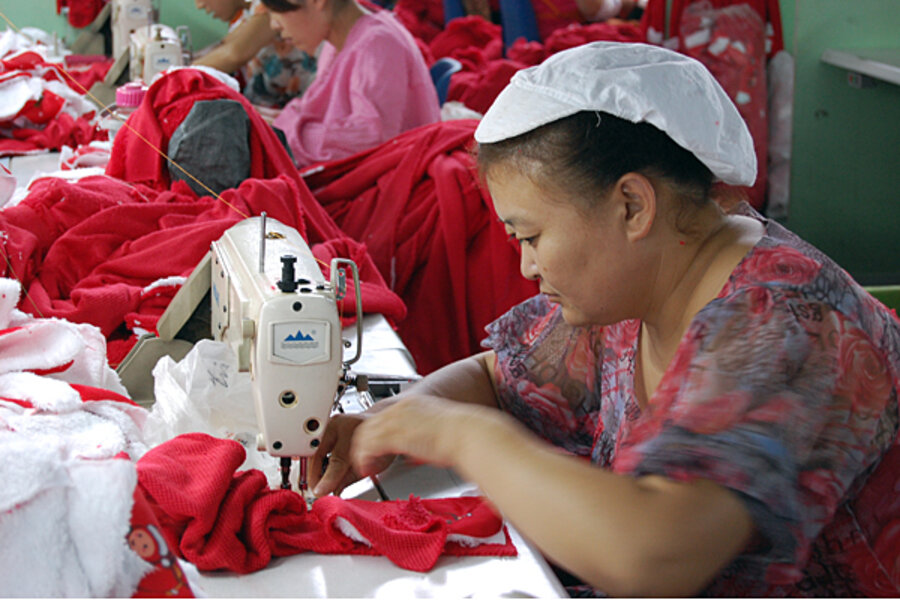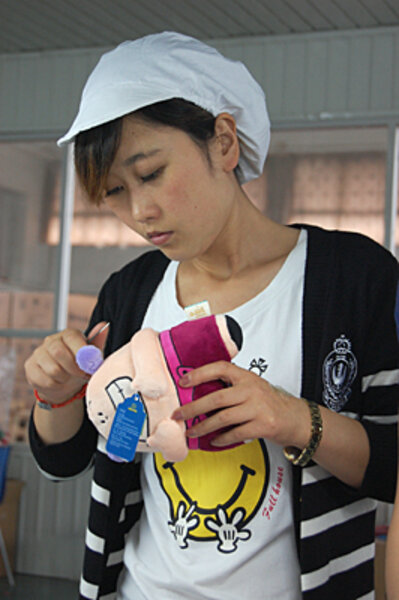As global economy slows, Chinese factory shifts sights from Europe to home
Loading...
| Jixian, China
For two decades, every plush toy that the Kaiyee factory churned out was packed off to Europe or Japan. Like tens of thousands of Chinese firms, Kaiyee thrived on exports.
Not anymore. As Christmas approaches this year, the women bent over sewing machines in this industrial suburb of the port city of Tianjin are making red furry children's scarves for a Chinese chain of supermarkets.
The bottom has fallen out of the European toy market, says Kaiyee manager Sun Shulun. The euro crisis means that “I don’t think Europeans are buying gifts the way they used to,” he laments. “Our sales to Europe have gone down 50 percent since 2010.”
Kaiyee is at the sharp end of a dramatic slowdown in China’s economic growth, long one of the wonders of the modern world. Annual growth in the second quarter of this year reached only 7.6 percent; that may sound high to American ears, but it was the lowest pace China had seen for three years, and marked the economy’s sixth straight quarter of declining growth rates.
That is bad news for the rest of the world; as Chinese companies adjust to the slowdown by producing and investing less, they need less of the machinery that countries such as the US, Germany, and Japan make, and fewer of the raw materials that commodity producers in Australia, Africa, and Latin America sell.
August’s trade figures were eloquent. Chinese imports actually fell by 2.6 percent – an almost unheard-of drop. Exports grew by an anemic 2.7 percent and are on course to increase by less than 10 percent over the year as a whole. That compares with annual leaps of 30 percent and more in recent decades.
Disappointing exports are only part of the reason for China’s slowing growth. Compounding the problem has been a similar trend in construction, the other main motor for Chinese economic growth, because of the sector’s appetite for cement, steel, and other products.
Construction is down because the government got spooked last year by a housing bubble and took steps to make it harder and more expensive to buy property. That lowered property prices and discouraged more construction.
The bubble had been inflated in the first place by the $600 billion stimulus plan that the authorities unleashed in 2008 and 2009 to hold the Chinese economy clear of the global financial and economic crisis.
The plan worked, but at a price. Inflation took off, along with home prices, banks made a lot of bad loans in their rush to flood the economy with credit, and local governments saddled themselves with a lot of bad debt.
Government acts – but it's not riding to the rescue
That’s why, this time, the government does not seem keen to step in too firmly to try to reverse the slowdown in growth, says Andrew Batson, an analyst with the Dragonomics business consultancy in Beijing.
“There is a general consensus in the government that the stimulus response to the crisis in 2008 was excessive,” says Mr. Batson. “They won’t do it again.”
A commentary published on Wednesday by the state news agency Xinhua made the same point. “Many have expected the government to announce an aggressive plan … to keep the economy from stalling a second time,” the article said. “However, a massive stimulus plan is not only unlikely, but would be detrimental to the country’s sustainable growth.”
Not that the authorities have been sitting idly by as the Chinese economy has tanked. The central bank has reduced interest rates twice this summer, and encouraged banks to lend by cutting their reserve requirements three times in the past year. The government has tinkered with tax and other measures to make life easier for exporters.
“But what has surprised people this year is that the government seems quite serious about not riding to the rescue” in the way it did four years ago, says Batson.
“In 2008, the central government was very determined to promote investment, but now the thinking has changed and they do not want to move so fast,” agrees Ye Tan, an independent economic commentator.
(Last week’s government announcement of $150 billion worth of infrastructure projects appeared to some analysts as a mini-stimulus plan; on closer inspection it was clear the projects had been approved over the past five months, and were just being announced as a package.)
The authorities’ desire to see investment growth cool could be a first step toward the long-awaited rebalancing of the Chinese economy that US Treasury Secretary Timothy Geithner has been pleading for.
China’s growth has long been driven by exports and fixed asset investment; it would be more sustainable if it depended more on domestic consumption and foreign governments would be happier too because if Chinese consumers were buying more it would be easier to sell them foreign goods.
Kaiyee shows the way
The Kaiyee factory is showing the way that the Chinese authorities say they want to go – targeting their sales at local consumers. But it is hard to see this becoming a general pattern very soon.
Rebalancing will happen only when investment grows more slowly than GDP and consumption grows more quickly. “But that will not happen in the near future,” says Ms. Ye, because it will require household incomes to rise as a share of GDP and that is not happening.
If investment growth and export growth slow down, while consumption does not pick up speed, the inevitable result will be slower overall economic growth than China has grown accustomed to.
The government has set a target of 7.5 percent for this year, and most analysts predict the economy will meet that goal. But China needs to add 24 million jobs a year to its economy to absorb its school and college graduates, and growth of much less than 7 percent would not create them.
A shortfall, and significant youth unemployment, could pose serious social problems for China’s next government, due to take over by the end of this year.
But for the time being, says Batson, “the government is cushioning things but it is not trying to push up demand and guarantee instant growth; that’s a big change.”







